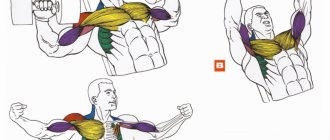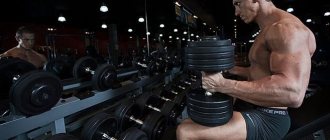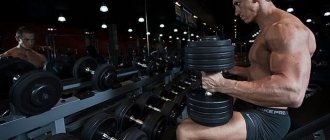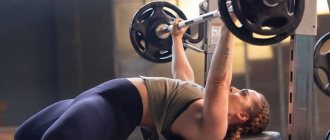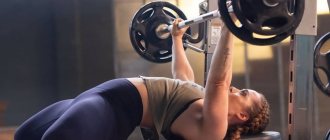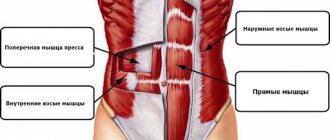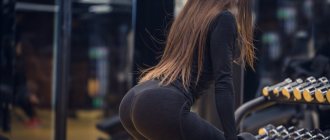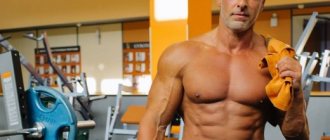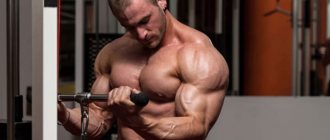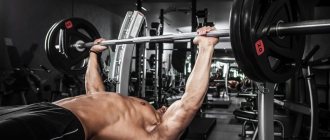Author of the article
Andrey Belozertsev
Drawing up programs for effective muscle mass gain.
Most often, when assessing a person’s muscularity, we involuntarily pay attention to his arms and chest.
These body parts are relatively easy to work on.
They are the calling card and pride of every bodybuilder.
This article will discuss how to quickly pump up your arms and chest at home.
Methods for pumping at home without exercise equipment
You can pump up your arms and chest at home by training with your own weight.
You can also use inexpensive, compact and mobile sports equipment: weights, dumbbells, universal expander.
It is also recommended to exercise on public sports grounds, training on the uneven bars and horizontal bar.
Push-ups, dips, pull-ups, and exercises with dumbbells are very effective.
To quickly pump up your arms and chest, you need to decide on the final goal.
If you want to achieve great definition, you need to perform exercises in a dynamic mode and do shallow push-ups and curls.
If your goal is to gain a large amount of muscle mass, you need to increase the weight of the equipment and reduce the number of approaches.
What to use to do biceps exercises at home?
It is impossible to develop your muscles just by bending your arms. Therefore, you will need to use some kind of weight to create additional stress on the biceps. Suitable for these purposes:
- Something heavy. For example, a briefcase filled with sand or tools. You can also use large bottles, starting from 5 liters and ending with 20. Bags of vegetables or cereals can also act as improvised means for performing exercises aimed at developing biceps. But it’s better to pour their contents into a briefcase or bag. Since it is easier to do exercises with them. As a handle, you can use a small stick (for example a mop) or a towel. In a word, use your imagination and inspect your home for the presence of suitable things.
- Using your own body weight. Basically, these are exercises where resistance is created through the legs. We press them on the biceps, as if trying to straighten the arm. Due to this, the biceps muscle receives a huge load. And if you have access to the crossbar (installed at home, or there is a sports ground nearby). Then a huge range of different pull-ups opens up for you. Which load the biceps very well.
- Using a rubber expander. An excellent alternative to dumbbells and barbells are expanders. The load varies by their rigidity. The larger it is, the more difficult it is to perform the exercise. I have previously written an article dedicated to EXERCISES WITH AN EXPANDER. I advise you to familiarize yourself with it.
Of course, it is worth understanding that by training at home, we are unlikely to be able to develop the full potential of our biceps. Therefore, it is worth considering purchasing more professional equipment. Start with a resistance band or dumbbells. Or start going to the gym on a regular basis with a person who understands training.
How to quickly pump up your arms
Since the upper limbs consist of many muscle groups, we will briefly consider exercises for each part of the arm.
Previously, we told you how to remove your butt.
Small muscles: fingers, hands and wrists
It is not surprising that without tenacious, muscular fingers and strong palms it is impossible to achieve success in many sports.
Listed below are the most effective exercises for training these parts of the arms.
Push-ups on fingers
Such practices were considered the basis during the training of students of oriental martial arts.
Real masters could support their body weight on just a few phalanges.
Technique:
- Place your palms slightly narrower than shoulder width. Shift your weight to your fingers. It is imperative to ensure that your fingers do not bend too much or change their position during movement, otherwise it will be very difficult to avoid injury.
- It is necessary to go down while exhaling, as with the usual type of push-ups, only gradually it is recommended to reduce the number of supporting fingers. If such a load is still too heavy for you, you can lean on your knees.
- It is advisable to touch the floor with your chest while bending your elbows. You need to return to the starting position while inhaling.
Do 2-3 sets of 15-20 repetitions.
In another article, we discussed how to get toned abs in a week.
Hanging with weights
This seemingly simple exercise can tone the muscles of your hands, forearms and back.
Also, any hanging on the crossbar has a beneficial effect on the condition of the spinal column.
Stages and features:
- Starting position: hanging on a high horizontal bar, palms placed with a straight grip at a distance of about twenty centimeters from each other. You can use a heavy backpack as a weight.
- With straightened legs, trying not to sway, you need to hang for 80-90 seconds.
This exercise greatly pumps up your fingers and strengthens the small tendons of your hand.
Wrist flexion
In this case, you can use dumbbells, kettlebells or a barbell.
You need to do the following:
- Sit on a bench, place your feet shoulder-width apart, straighten your back and slightly tilt your body forward, place your forearms on your hips. Each hand must have a projectile.
- Perform flexion and extension of the wrists, raising the hand with the equipment up and down. It is advisable to linger at the extreme points and change the pace - from fast to slow and vice versa.
Do the exercise for two to three minutes.
Forearms
Pull-ups on fingers
The exercise is considered very difficult, so you can only start it if you have a sufficient level of physical fitness.
Technique:
- Hanging on a high horizontal bar, legs crossed, you can hold the weight on a maximum of three fingers.
- As you exhale, rise up, bending your elbows, and as you inhale, lower down.
You need to do at least two sets of 15-18 repetitions.
Recommended number of workouts
When studying video exercises for the chest muscles, it is important to remember that daily workouts until you break a sweat will not give the desired result. You will only overtrain and end up simply not being able to exercise. Muscles need to be given time to recover. This is the only way to achieve maximum effectiveness from the training.
It is recommended to do strength training no more than 2-3 times a week. To pump muscles evenly, you need to alternate exercises. For example, you should not perform only the bench press every session. Vary your training program. This way you will achieve the desired result faster and will not get bored during the training.
Another important point - do not try to lift as much weight as possible in record time. Especially if you have not fully mastered the technique of performing the exercises. Increase the load gradually.
Strengthening the upper pectoral muscles
Explosive push-ups
These clapping push-ups will help train your chest and abs. They also help pump up your arms and buttocks.
Technique:
- Palms should be placed shoulder-width apart. Elbows are slightly spread to the sides. The back is straight, the legs are as close to each other as possible.
- As you inhale, lower yourself, touching your chest to the floor, and as you exhale, sharply push yourself up, lifting your hands off the ground. You can change the position of your hands - wide or narrow grip. You can clap in front of your chest and behind your back during the flight stage. This already depends on the physical preparation of a particular person.
Do 2-3 sets of at least 20 push-ups. If you are a beginner, you can do the exercise without clapping.
Push-ups with a stop
This exercise is almost no different in technique from the “classic” push-up. Its distinctive feature is a long delay when lowering down.
Features and rules:
- Starting position: hands shoulder-width apart. First lowering your chest, and only then your hips, you need to bend your elbows and stay halfway down the “way” for as long as possible.
- Then he will go down and take another long pause near the floor. Such stops are very effective and provide a good pumping of the lower abs and chest.
Do 2-3 sets of 20-25 push-ups. In total, the pause should be 10-15 seconds per “path” down.
Incline push-ups
There are two variations: when the legs are higher than the head and installed on a hill, and vice versa.
If your palms are placed on a bench, this option is much simpler than the classic push-up, so it is only suitable as a good workout for children and young girls.
When your feet are on the bench, your body weight is almost completely transferred to your palms, which allows you to quickly pump up your abs, upper chest, front deltoids, triceps and back.
Execution technique and main steps:
- Place your palms wider than your shoulders, feet on your toes on a sports bench. As you inhale, you need to lower yourself down, almost touching your forehead to the floor. It is forbidden to throw your head back too much!
- As you exhale, straighten your elbows and return to the starting position. This exercise pumps up the abs at home, in addition to the muscles of the upper body. You can also pump up your abs by combining push-ups with incline and stops.
Perform 2-3 sets of 20-22 times.
Tips for effective muscle training at home
It is not difficult to pump up your biceps at home - it works indirectly when doing exercises on other parts of the body. It is much more difficult to make it sufficiently voluminous and attractive. Beginning athletes may encounter a number of difficulties:
| Biceps development rate | |
| Problem: in the first few months, the muscle grows by 1 cm in 8-12 weeks, and then its growth slows down. | Solution: You need to constantly adjust your training plan so that your biceps continue to grow actively enough. |
| Biceps and aesthetics | |
| Problem: Flat biceps are associated with arm weakness. | Solution: strength training at home or in the gym can make this muscle bigger and your arms more attractive. |
Three useful tips for those who want to work out their biceps:
- When performing biceps exercises at home, you need to alternate them with training other muscle groups. We must not forget about the brachialis muscle, which makes the biceps visually larger and more prominent.
- Maintain intervals between workouts. You cannot overload the muscle, so at least 1–2 days should pass between strength training sessions.
- Make sure to maintain correct body position when performing exercises. If it is incorrect, the muscle will not receive the proper load and the risk of injury will increase.
Exercises for the lower chest
Dips
Regular parallel bar push-ups also help pump up your chest. Before you begin this part of the workout, you need to be able to do a handstand on the parallel bars for at least four minutes.
Push-up nuances:
- Starting position: standing on your hands, elbows straight, legs bent at the knees, shins pressed against each other.
- As you inhale, you should go down as low as possible, and as you exhale, straighten your elbows and rise up.
Do a total of 60-70 repetitions, divided into 3-4 sets.
Common Mistakes
In order for chest muscle training to be as effective as possible, you must strictly follow the exercise technique and listen to the advice given by experienced athletes and coaches. Before you go to the gym or schedule a training program to practice at home, carefully study the video of exercises for the pectoral muscles. A clear example will help you quickly figure out what's what. But first, remember a few simple rules:
- Don't go for heavy weights. This does not guarantee the desired effect, and the risk of injury increases significantly.
- Don't use the same exercise every workout.
- Don't ignore exercise equipment. When used correctly, they help target specific muscle groups or lagging areas.
- Be sure to warm up before performing the main set of exercises.
- First of all, carefully work out the lagging muscles.
- Focus on working the pectoral muscles.
- Start each workout with basic exercises.
By following the recommendations listed above, you will achieve the desired result much faster. And in conclusion, we recommend that you familiarize yourself with another video that will help you figure out how to properly train the pectoral muscles.
How to pump up your chest correctly for a beginner
Beginners often worry about whether they will be able to get the desired result if they really do it all. In addition, there is laziness and a desire to somehow simplify classes.
In fact, you need to set yourself up and at least start doing exercises; the desire to play sports will appear as soon as you see the first fruits of your training.
Beginners are recommended to do more approaches, but with less load. This way, you can quickly get used to the exercises, and then gradually increasing the load, you can calmly get into the rut.
Don’t forget about a healthy diet, which should be planned down to the smallest detail, give up tasty treats, and focus on protein foods.
Combine a healthy diet with training, you can quickly gain muscle mass, and thanks to constant exercise, the protein entering your body will quickly be distributed between the muscles that you are currently working.
You can take into account world athletes to motivate yourself to pump up your chest. Go to master classes, since pumping up the pectoral muscles is not so easy.
The best representative of his occupation is Arnold Schwarzenegger. A video with Schwarzenegger will tell you how to properly pump up your chest; the famous champion made a significant contribution to the sport and shared his success with a beginner.
Work out with a trainer or spend enough time practicing at home, don’t lose your spirit and strive for better results. Without a doubt, you will succeed!
Recommendations for effective pumping of the inner chest area
There are several basic principles that help achieve more effective results:
♦ internal training is performed twice a week, between training there should be 2-3 days of rest;
♦ do not exclude the classic bench press from your training, this is a basic exercise for developing the entire mass of the pectoral muscles and will only be an assistant for building up the inner part of the pectoral muscles;
♦ it is necessary to increase the working weight every 2-3 workouts, which will allow more and more muscle fibers to be involved in the work and will not allow the muscles to get used to a monotonous load;
♦ during 1 exercise it is necessary to perform 1-2 warm-up approaches and 3-4 working approaches with the main weight. The number of repetitions should be 8-12 for building mass, and 12-15 repetitions for drawing and performing isolation exercises.
♦ chest training always involves the shoulder joints, so in order to avoid injury before chest training, it is always necessary not only to warm up in the chest area, but also the shoulder girdle.
